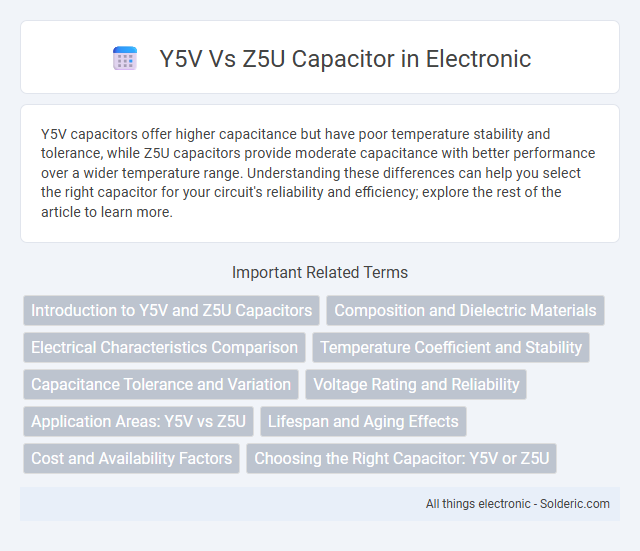Y5V capacitors offer higher capacitance but have poor temperature stability and tolerance, while Z5U capacitors provide moderate capacitance with better performance over a wider temperature range. Understanding these differences can help you select the right capacitor for your circuit's reliability and efficiency; explore the rest of the article to learn more.
Comparison Table
| Feature | Y5V Capacitor | Z5U Capacitor |
|---|---|---|
| Dielectric Material | Barium Titanate | Barium Titanate |
| Temperature Range | -30degC to +85degC | +10degC to +85degC |
| Capacitance Tolerance | +22% / -82% | +22% / -56% |
| Capacitance Stability | Very poor, high variation with temperature | Poor, less variation compared to Y5V |
| Application | General purpose, low-cost, non-critical circuits | Basic applications with moderate stability needs |
| Voltage Ratings | Low to Medium (typically 16V to 50V) | Low to Medium (typically 16V to 50V) |
| Permittivity | High dielectric constant, higher capacitance per volume | Moderate dielectric constant |
| Cost | Lower | Moderate |
Introduction to Y5V and Z5U Capacitors
Y5V and Z5U capacitors are ceramic capacitors commonly used in electronic circuits for filtering and decoupling applications. Y5V capacitors offer high capacitance values with lower stability, typically ranging from -82% to +22% capacitance variance over temperature. Z5U capacitors provide moderate capacitance stability, with a temperature range of +22% to -56%, making both types suitable for non-critical timing and bypass circuits where cost efficiency is prioritized.
Composition and Dielectric Materials
Y5V capacitors typically use barium titanate-based ceramic dielectrics with additives that result in high dielectric constant but poor temperature stability, making them suitable for general-purpose applications requiring large capacitance values in small packages. Z5U capacitors utilize a similar dielectric composition with modifications to improve temperature performance, operating reliably between +10degC and +85degC, though with moderate dielectric stability. Both Y5V and Z5U belong to Class II ceramic capacitors, but their dielectric formulations differ in temperature coefficient and capacitance tolerance due to variations in ceramic additives and firing processes.
Electrical Characteristics Comparison
Y5V capacitors typically offer higher capacitance values but suffer from poor temperature stability and a wide tolerance range, making them less reliable for precision electronics. Z5U capacitors provide moderate capacitance with improved temperature characteristics and slightly better tolerance, suitable for general-purpose applications. When selecting a capacitor for your design, consider that Y5V's capacitance can vary by +22% to -82% over temperature, whereas Z5U varies from +22% to -56%, impacting circuit performance.
Temperature Coefficient and Stability
Y5V capacitors exhibit a wide temperature coefficient of +22% to -82%, resulting in poor stability across temperature variations, while Z5U capacitors offer a narrower range of +22% to -56%, providing slightly better but still limited stability. Both types are classified as high dielectric constant class II ceramic capacitors, making them suitable for applications where capacitance tolerance and temperature stability are not critical. You should choose Z5U capacitors if moderate temperature stability is needed, but neither option is ideal for precision temperature coefficient requirements.
Capacitance Tolerance and Variation
Y5V capacitors exhibit a wide capacitance tolerance typically around +80%/-20%, with significant capacitance variation over temperature and voltage, often changing by +-40% to +-70%. In contrast, Z5U capacitors have a narrower tolerance usually around +22%/-56%, but experience more stable capacitance variation within +-30% across their specified temperature range. Both types are classified as high-K ceramic dielectrics, primarily used in applications where capacitance variation is acceptable but cost and size are prioritized.
Voltage Rating and Reliability
Y5V capacitors generally offer higher voltage ratings up to 50V, while Z5U types typically handle lower voltages around 10V to 30V. Y5V capacitors provide less stability and reliability due to greater capacitance variation with temperature and voltage changes. Your application requires careful consideration of voltage rating and performance consistency between these ceramic capacitor types.
Application Areas: Y5V vs Z5U
Y5V capacitors are commonly used in applications requiring stable capacitance over a wide temperature range and moderate voltage, such as in decoupling, filtering, and coupling in electronic circuits. Z5U capacitors, with their higher capacitance and lower stability, are often found in non-critical applications like timing circuits, power supply bypass, and general-purpose use where cost efficiency is prioritized over precision. Your choice between Y5V and Z5U should align with the specific stability and performance requirements of your electronic design.
Lifespan and Aging Effects
Y5V capacitors typically have a shorter lifespan and exhibit more significant aging effects, with capacitance values decreasing rapidly over time due to temperature and voltage stress. Z5U capacitors offer improved aging stability and a longer operational life, maintaining capacitance more consistently under similar environmental conditions. Both types experience capacitance degradation, but Z5U capacitors are preferred in applications requiring better longevity and reliability.
Cost and Availability Factors
Y5V capacitors are generally more cost-effective and widely available due to their common use in low-cost electronics, making them suitable for budget-sensitive projects. Z5U capacitors tend to be slightly more expensive and less readily stocked, as their temperature stability features target specific applications. Considering Your requirements and procurement constraints, opting for Y5V may result in easier sourcing and reduced expenses.
Choosing the Right Capacitor: Y5V or Z5U
Choosing the right capacitor between Y5V and Z5U depends on your application's temperature stability and capacitance tolerance requirements. Y5V capacitors offer a wider capacitance range but exhibit higher variation with temperature changes, making them suitable for non-critical filtering tasks, whereas Z5U capacitors provide better stability and tighter capacitance tolerance over temperature, ideal for timing and coupling circuits. Assess your circuit's sensitivity to temperature fluctuations and capacitance drift to ensure optimal performance with your chosen capacitor.
Y5V vs Z5U capacitor Infographic

 solderic.com
solderic.com